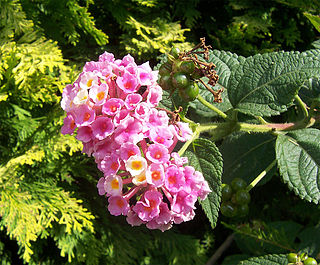
The Verbenaceae, the verbena family or vervain family, is a family of mainly tropical flowering plants. It contains trees, shrubs, and herbs notable for heads, spikes, or clusters of small flowers, many of which have an aromatic smell.

The Celastraceae are a family of 98 genera and 1,350 species of herbs, vines, shrubs and small trees, belonging to the order Celastrales. The great majority of the genera are tropical, with only Celastrus, Euonymus and Maytenus widespread in temperate climates, and Parnassia (bog-stars) found in alpine and arctic climates.

Lithophytes are plants that grow in or on rocks. They can be classified as either epilithic or endolithic; epilithic lithophytes grow on the surfaces of rocks, while endolithic lithophytes grow in the crevices of rocks. Lithophytes can also be classified as being either obligate or facultative. Obligate lithophytes grow solely on rocks, while facultative lithophytes will grow partially on a rock and on another substrate simultaneously.

Iochroma is a genus of about 34 species of shrubs and small trees belonging to the nightshade family Solanaceae. Species are native from Mexico to south Brazil. They are found in the forests of Mexico and South America. Their hummingbird-pollinated flowers are tubular or trumpet-shaped, and may be blue, purple, red, yellow, or white, becoming pulpy berries. The cupular (cup-shaped) calyx is inflated in some species. The leaves are alternate, simple, and entire.

The Lecythidaceae comprise a family of about 20 genera and 250–300 species of woody plants native to tropical South America, Africa, Asia and Australia.

Discaria is a genus of 6 species of flowering plants in the family Rhamnaceae, native to temperate regions of the Southern Hemisphere, in Australia, New Zealand and South America.

Menispermaceae is a family of flowering plants. The alkaloid tubocurarine, a neuromuscular blocker and the active ingredient in the 'tube curare' form of the dart poison curare, is derived from the South American liana Chondrodendron tomentosum. Several other South American genera belonging to the family have been used to prepare the 'pot' and 'calabash' forms of curare. The family contains 78 genera with some 440 species, which are distributed throughout low-lying tropical areas with some species present in temperate and arid regions.
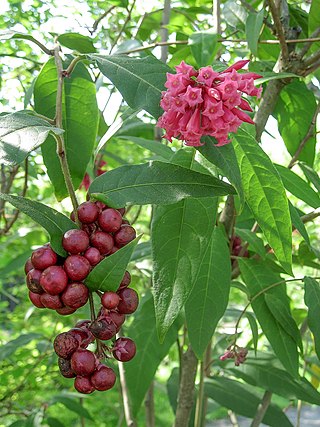
Cestrum is a genus of — depending on authority — 150-250 species of flowering plants in the family Solanaceae. They are native to warm temperate to tropical regions of the Americas, from the southernmost United States south to the Bío-Bío Region in central Chile. They are colloquially known as cestrums or jessamines.

Triuridaceae are a family of tropical and subtropical flowering plants, including nine genera with a total of approximately 55 known species. All members lack chlorophyll and are mycoheterotrophic. The heterotrophic lifestyle of these plants has resulted in a loss of xylem vessels and stomata, and a reduction of leaves to scales.

Fulvio Bernardini was an Italian football player and coach who played as a midfielder. He is regarded as one of Italy's greatest ever footballers and managers.

The Icacinaceae, also called the white pear family, are a family of flowering plants, consisting of trees, shrubs, and lianas, primarily of the tropics.

Allonsanfàn is a 1974 Italian historical drama film written and directed by Paolo and Vittorio Taviani. The title of the film, which is also the name of a character, comes from the first words of the French Revolutionary anthem La Marseillaise.

John Miers, FRS FLS, knight grand cross of the Order of the Rose, was a British botanist and engineer, best known for his work on the flora of Chile and Argentina.
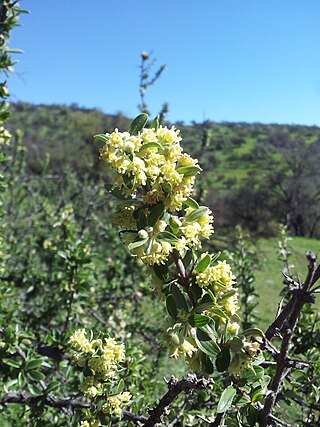
Trevoa is a genus of actinorhizal plants; these dicotyledon flora are trees or small shrubs. The genus was first proposed by Miers in 1825, but was not fully described until 1830 by Sir William Jackson Hooker. Genus members are notable for their ability to fix nitrogen. Species of this genus are generally found in the near coastal forests and arid shrubland of South America. Some species are localized in the mountains of central Chile; for example, the species Trevoa trinervis occurs in the La Campana National Park and other proximate areas of central Chile.
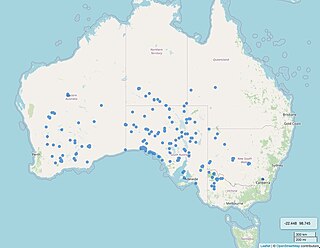
Kippistia is a genus of flowering plants in the family Asteraceae. The name commemorates Richard Kippist, librarian to the Linnean Society.

Hexapodidae is a family of crabs, the only family in the superfamily Hexapodoidea. It has traditionally been treated as a subfamily of the family Goneplacidae, and was originally described as a subfamily of Pinnotheridae. Its members can be distinguished from all other true crabs by the reduction of the thorax, such that only seven sternites are exposed, and only four pairs of pereiopods are present. Not counting the enlarged pair of claws, this leaves only six walking legs, from which the type genus Hexapus, and therefore the whole family, takes its name. Some anomuran "crabs", such as porcelain crabs and king crabs also have only four visible pairs of legs. With the exception of Stevea williamsi, from Mexico, all the extant members are found either in the Indo-Pacific oceans, or around the coast of Africa.

Fulvio Pea is an Italian football coach.
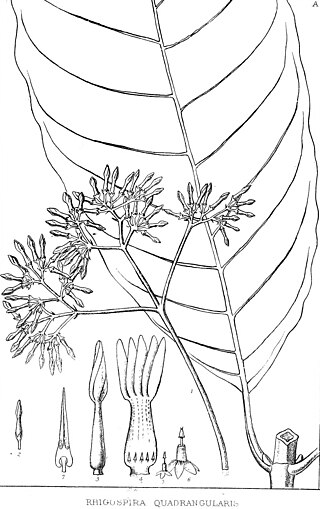
Rhigospira is a genus of flowering plants in the family Apocynaceae, first described as a genus in 1878 by John Miers. The species, Rhigospira quadrangularis was first described as Ambelania quadrangularis by Johannes Müller Argoviensis in 1860 but was transferred to the genus, Rhigospira, in 1878 by John Miers. The genus contains only one known species, Rhigospira quadrangularis, native to northwestern South America.

The Solanaceae, or the nightshades, are a family of flowering plants that ranges from annual and perennial herbs to vines, lianas, epiphytes, shrubs, and trees, and includes a number of agricultural crops, medicinal plants, spices, weeds, and ornamentals. Many members of the family contain potent alkaloids, and some are highly toxic, but many—including tomatoes, potatoes, eggplant, bell and chili peppers—are used as food. The family belongs to the order Solanales, in the asterid group and class Magnoliopsida (dicotyledons). The Solanaceae consists of about 98 genera and some 2,700 species, with a great diversity of habitats, morphology and ecology.

Francesco Di Fulvio is an Italian professional water polo player. He was part of the Italian team at the 2016 Summer Olympics, where the team won the bronze medal.



















